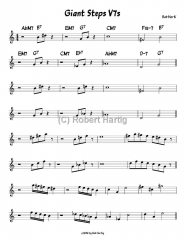I’ve recently been focusing on the Giant Steps cycle during my practice sessions, with the thought that at some point soon, once I’m ready for prime time, I’ll record myself. It seems only right that a guy with the audacity to write a book of Giant Steps licks and patterns ought to furnish some evidence that he can actually play the tune. So I’ve been getting myself up to snuff.
But it’s one thing to play “Giant Steps” and another thing to play it creatively. As you know if you play or have attempted to play the tune yourself, the A section in particular is a challenge. So I was pleased with the breakthrough of sorts that I experienced the other night, which I continued to explore during this evening’s practice with good results.
In the changes to “Giant Steps,” bars 2–3 and 5–6 alternate tonic major chords with dominant seventh chords in a framework of rapid modulations through three key centers spaced a major third apart. For the Eb alto sax, the first two bars proceed thus: AbM7 B7 / EM7 G7; and bars five and six are as follows: EM7 G7 / CM7 Eb7. You can distill all of that into a single cycle, thus: AbM7 B7 / EM7 G7 / CM7 Eb7, after which the cycle repeats itself.
I’ve tended to focus on the major chords–in other words, the first chord in each measure. But I’m finding that spotlighting the dominant seventh chords is helping me to improve my command of the changes. For practice purposes, my approach–or at least, part of my approach–is to omit the major chords entirely, forcing me to think exclusively about the dominant chords and what I want to do with them. Right now I’m keeping it simple, sticking with essential chord tones. In a while, I’ll start altering upper extensions and probably incorporating tritone substitutions. But first I want to get basic chords drilled into both my fingers and my mind.
On this page I’ve included a few simple patterns that I’ve been working with. (Click on the image above to enlarge it.) They’re nothing fancy, and they’re not intended to be. But if you work with them when you practice “Giant Steps,” I think you’ll find that they make you think in a different way which will help you wrap your mind around the changes better.
These patterns are just to get you started. I encourage you to make up your own patterns, and don’t be shy about using wider intervals such as fifths and sixths. I should add, at the risk of stating the obvious, that you should transpose the patterns according to the dictates of your instrument: up a minor third for flute, piano, and other concert pitch instruments, and up a perfect fourth for Bb instruments such as the tenor sax and trumpet.
Practice hard and have fun!


